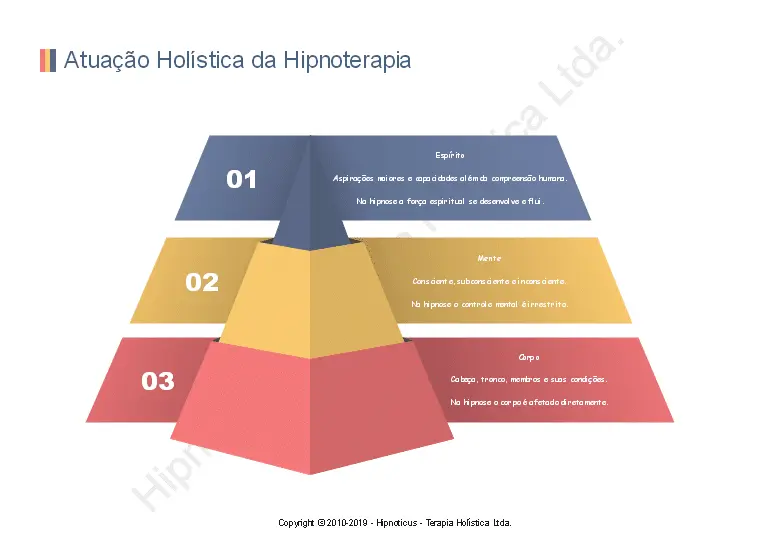How does hypnotherapy work?
Hypnotherapy, using hypnosis (learn more at: how hypnosis works?) as a channel of communication with the non-conscious mind (also known as the subconscious or unconscious) acts to solve problems and improve conditions and personality.
Everything can be improved and solved in hypnotherapy.
Scope of Hypnotherapy: spirit, mind and body

Image 1. Scope of Hypnotherapy (2019) - Hipnoticus — Hypnosis, Health & Well-Being
Image 1 Caption
1.1. Spirit: Greater aspirations and capabilities beyond human comprehension. In hypnosis, spiritual strength develops and flows.
1.2. Mind: Conscious, subconscious and unconscious. In hypnosis, mental control is unrestricted.
1.3. Body: Head, trunk, limbs and their conditions. In hypnosis, the body is directly affected.
The unconscious in hypnotherapy and in your life
In hypnotherapy, we use your unconscious mind to change the structure of your behaviors, thoughts, reactions, personality, beliefs, emotions and goals in the way you choose and prefer. The hallmark of hypnotherapy is focus: focus on your result, on what you want.
Your unconscious mind is responsible for generating sensations, emotions, for keeping your heartbeat and breathing at a certain rhythm, also responsible for keeping your heart beating, in addition to putting you to sleep at the right time, without you making much effort, and for making all your senses function correctly.
An interesting way to analyze the role of the unconscious mind is to first analyze the role of the conscious mind: to observe, choose and rationalize.
Since you chose to read this text now, we could easily attribute this function to your conscious mind. Which also analyzes: 2 + 2 = 5. Correct? And he rationalizes: if I am reading this text on the computer screen, my eyes must be closed; I must be imagining this text.
It may have been uncomfortable. But the paragraph above is a good example to show how your conscious mind is clearly and obviously responsible for some basic daily functions. Now, probably not so clearly and obviously to you, it would be this same conscious mind dependent on non-conscious emotional angers in their entirety.
Certainly, one individual, one reaction, two individuals, two reactions. However, such glaring errors irrevocably generate discomfort in most people.
Steps of the Process
1. (2 + 2 = 5) = 2. Wrong = 3. Discomfort
Literal Translation of the Process
1. Conscious -> 2. Stored Conscious Definition -> 3. Non-Conscious Response
And it is precisely the feeling of discomfort that was generated by your non-conscious mind. Your conscious mind could only observe the sensations of discomfort, or any other sensation generated by your non-conscious. Your non-conscious mind is an expert in taking care of most of your activities.
Or do you think that you are responsible for consciously sending blood and oxygen to your brain while you breathe?anger? Yes, they are physiological reactions, but they do not always maintain the same rhythm or functioning, and your subconscious is entirely responsible for managing these functions in the best possible way; whether the behavior of these reactions is stable or unstable.
In hypnotherapy, using hypnosis as a tool for managing subconscious reactions (it is even possible to prevent discomfort from being generated by such blatant errors) and as a potentializing path, we have great ease in changing your behaviors, thoughts, reactions, personality, stored definitions and, consequently, your emotions.
The power of the unconscious in therapeutic change
Many already know that hypnosis is something powerful. Or they think. Or they believe (or want to believe). Since stage hypnosis clearly demonstrates what is possible to be done with the use of the hypnotic state. But it is important to remember: aberrative demonstrations apply only to the stage, not to the clinical and therapeutic environment.
The aberrative potential of the stage should be considered as a well of curiosities about how our mind is capable of transforming us under such simple, yet still powerful stimuli.
This same circus power of hypnosis on stage can be compared to the power of hypnosis in therapy, without any exception and also without any comparison.Therapy will never stop being therapy and hypnotherapy is no different.
However, when it comes to hypnosis, we first talk about therapy and the ability to change under command, on one's own demand, then about play and fun, these becoming simple variations of the human potential to propagate changes, to satisfy one's creative and artistic desires; but nothing in the office, nothing. Play has a place and time, and its place is well reserved on the stage.
All personal transformation, therapeutic or not, has as its objective the non-conscious, spontaneous and intrinsic change to the being, non-forced and natural.
Hypnotherapy is the therapeutic methodology that offers the hypnotic channel, user and maximum enhancer of non-conscious faculties, as the therapeutic modality that is the mother of all other therapies; as these aim to change the uncontrollable, the non-conscious cause, beyond control.
If all therapy seeks to give control of the uncontrollable in the individual, all are, in their variations, forms of hypnosis; maximizing, enhancing, or here again, minimizing the non-conscious power.
However, results on stage are obtained with blatant and almost dubious ease. In the therapeutic environment, the same ease can be reproduced, however, with due care and studies of pre and post hypnotic application, even though these results in both contexts (stage and office) are completely different.
It is concluded that all behavior must be managed, if possible reinforced, remodeled, improved and properly matured, also through hypnotic therapy, never being abandoned even after more than 1 procedure, as any investment, stage, instantaneous, momentary, much less treated frivolously, leaving the hypnotized lost, as beings who do not know where to go.
Hypnotherapy, compared to stage hypnosis or the common form of hypnosis, not therapeutically focused, here understood as neutral, which consists of the search for the state itself, as beginning, middle and end, can be seen as a procedure where repetition, reinforcement and management of the trance are essential for success to be obtained and created satisfactorily, something inherent to every therapeutic process and to any interpersonal change that requires maturity.
Deep trance or therapeutic depth?
Contrary to what is commonly thought, effective hypnotherapy does not require, much less focus on, a deep trance in order to obtain good therapeutic results.
Several hypnotized people say they remembered everything, heard the hypnotist's voice, did not lose consciousness, did not leave their body during the hypnotic trance, did not relive past lives, did not remember a childhood trauma, did not imitate animals, did not eat onions thinking they were apples and felt they were in control of everything.
Some people, in fact, say that they have not experienced a trance at all. If you are one of those people,of these, know: this is the hypnotic trance. Especially when we talk about hypnotherapy, all the hypnotic phenomena above are optional when we seek therapeutic results.
The hypnotherapeutic focus is always different: therapeutic depth. The changes must be profound, stable and capable of maturing, stabilizing, and becoming part of the life of the hypnotized individual.
Suggestion: how to view hypnotherapy from now on
After reading this text, it would be extremely interesting to see hypnotherapy as a possibility of transformation or acceleration of your current therapeutic process.
Another recommendation is to begin to understand that hypnosis is something natural, a phenomenon already inherent to man. Also keep in mind that hypnosis sessions are pleasurable, either because they promote good relaxation or because they promote pleasant stimuli, both focused on the sole purpose of promoting your personal transformation.
Read also: What is hypnotherapy?




 (artigo aguardando avaliação pública)
(artigo aguardando avaliação pública)
